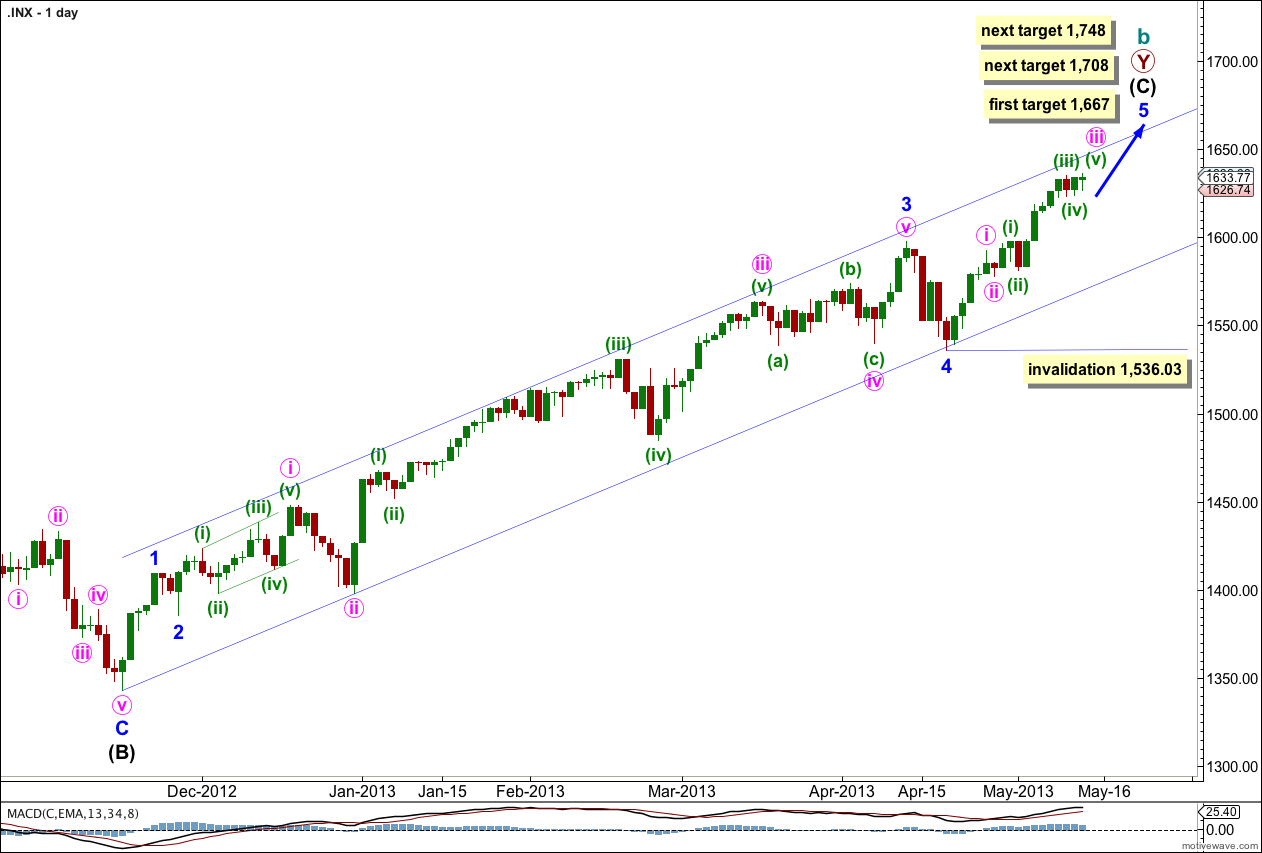Last analysis expected upwards movement for Monday’s session which is what happened. Price is well short of the target but the structure is incomplete.
Click on the charts below to enlarge.
This trend is not over and price should continue to move higher for maybe about another few weeks.
Draw a channel about intermediate wave (C) here on the daily chart. Draw the first trend line from the start of intermediate wave (C) to the low of minute wave ii within minor wave 3. Place a parallel copy to contain all this upwards movement. So far this channel shows very closely where price is finding support and resistance and should continue to do so.
The wave count within minor wave 3 fits with MACD as an indicator of momentum. The strongest piece of upwards movement within intermediate wave (C) corresponds to the middle of a third wave.
Within intermediate wave (C) minor wave 4 is over and minor wave 5 is underway. Because there is no Fibonacci ratio between minor waves 1 and 3 I would expect to see a ratio for minor wave 5.
Minor wave 5 is showing subdivisions at minute degree on the daily chart, and minute wave iii within it is also showing subdivisions on the daily chart which is very common.
Minor wave 5 has passed equality with minor wave 1 and is extending. At 1,667 (which now looks unlikely) minor wave 5 would reach 0.618 the length of minor wave 3. If price keeps rising through this first target, or if when it gets there the structure is incomplete, then the next target is at 1,708 where minor wave 5 would reach 2.618 the length of minor wave 1. Again, if price continues higher through this target the next possible end would be at 1,748 where minor wave 5 would reach equality in length with minor wave 3.
It would be somewhat unlikely that minor wave 5 would be longer than the extended minor wave 3.
Within minor wave 5 no second wave correction may move beyond the start of its first wave. This wave count is invalidated with movement below 1,536.03.
Price did move a little higher and a diagonal structure can be seen on the five minute chart. This may be minuette wave (v) already completed, sooner than expected. This is my main wave count because the Fibonacci ratios within it are excellent.
We may see the start of a larger fourth wave correction tomorrow which should end about the fourth wave of one lesser degree at 1,629.19.
This wave count would be confirmed with price movement below 1,623.09 as at that stage the alternate hourly wave count below would be invalidated.
If minute wave iii is over it is just 1.83 points longer than equality with minute wave i.
Ratios within minute wave iii are: minuette wave (iii) is just 0.89 points short of 2.618 the length of minuette wave (i), and minuette wave (v) is just 0.54 points short of 0.618 the length of minuette wave (i).
The guideline of alternation indicates minute wave iv should be a flat, combination or triangle structure. It may be a deep correction, but we may see alternation in structure and not in depth. Price may find support at the lower edge of the parallel channel.
Minute wave iv should last between one to four days. It should be clearly seen on the daily chart.
Minute wave iv may not move into minute wave i price territory. This wave count is invalidated with movement below 1,592.64.
Alternate Hourly Wave Count.
If we simply move the degree of labeling within the diagonal structure down one degree it may be a leading diagonal for subminuette wave i.
If we see upwards movement tomorrow then this alternate would be a good explanation.
Following a leading diagonal in a first wave position we should expect to see a deep second wave correction. Subminuette wave ii is very likely to move lower to start tomorrow’s session, before price turns back upwards with a small increase in upwards momentum.
Downwards movement should find support at the lower edge of the parallel channel drawn here about minor wave 5. Draw this channel with the first trend line from the start of minor wave 5 to the low of minuette wave (ii) within minute wave iii. Place a parallel copy upon the high of minute wave i.
At 1,674 minuette wave (v) would reach equality in length with minuette wave (iii). However, there is already an excellent Fibonacci ratio between minuette waves (i) and (iii) so we may not see a Fibonacci ratio between minuette wave (v) and either of (i) or (iii). For this reason I favour the lower end of the target zone.
At 1,669 minute wave iii would reach 1.618 the length of minute wave i.
When minute wave iii is complete then I will move the invalidation point back down to the high of minute wave i at 1,592.64. For tomorrow it will be at 1,623.09 because subminuette wave ii may not move beyond the start of subminuette wave i.



